Uni-T UT58C Handleiding
Uni-T
Multimeter
UT58C
Bekijk gratis de handleiding van Uni-T UT58C (2 pagina’s), behorend tot de categorie Multimeter. Deze gids werd als nuttig beoordeeld door 48 mensen en kreeg gemiddeld 4.3 sterren uit 24.5 reviews. Heb je een vraag over Uni-T UT58C of wil je andere gebruikers van dit product iets vragen? Stel een vraag
Pagina 1/2

(See Figure 5)
Transistor Test
for
Overview
Warning
To avoid electric shock or personal injury, read the
“Safety Information”, carefully before using the Meter.
Digital Multimeters Model UT58A, UT58B and UT58C
are 2000-count hand-held instruments with remarkable
features: ex-large LCD, steady operations, overload
protection for all ranges and unique structure. The
Meter can measure AC/DC voltage, AC/DC current,
resistance, capacitance, temperature, frequency,
transistor, diode and continuity, and is equipped with
data hold, full icon display and sleep mode functions.
Unpacking Inspection
In the event you find any missing or damaged part,
please contact your dealer immediately.
1 English Operating Manual
2 Test Lead
3 Multi-Purpose Socket
4 Point Contact Temperature Probe
(UT58B/UT58C only)
5 9V Battery (NEDA 1604, 6F22 or 009P)
Item Description Qty
1 pc
1 pair
1 pc
1 pc
1 pc
Safety Information
This Meter complies with the standards IEC61010:
Pollution Degree 2, Overvoltage Category (CAT. II 1000V,
CAT. III 600V) and Double Insulation.
CAT. II: Local level, appliance, PORTABLE EQUIPMENT
etc., with smaller transient voltage overvoltages than
CAT. III
CAT. III: Distribution level, fixed installation, with smaller
transient overvoltages than CAT. IV
Use the Meter only as specified in this operating manual,
otherwise the protection provided by the Meter may be
impaired.
In this manual, a identifies conditions andWarning
actions that pose hazards to the user, or may damage
the Meter or the equipment under test.
A identifies the information that usNote er should pay
Warning
To avoid possible electric shock or personal injury,
and to avoid possible damage to the Meter or to the
equipment under test, adhere to the following rules:
Before using the Meter inspect the case. Do not
use the Meter if it is damaged or the case (or part
of the case) is removed. Look for cracks or missing
plastic. Pay attention to the insulation around the
connectors.
Inspect the test leads for damaged insulation or
exposed metal. Check the test leads for continuity.
Replace damaged test leads with identical model
number or electrical specifications before using
the Meter.
Do not apply more than the rated voltage, as
marked on the Meter, between the terminals or
between any terminal and grounding.
The rotary switch should be placed in the right
position and no any changeover of range shall
be made during measurement to prevent damage
of the Meter.
When the Meter working at an effective voltage
over 60V in DC or 30V rms in AC, special care
should be taken for there is danger of electric
shock.
Use the proper terminals, function, and range
for your measurements.
If the value to be measured is unknown, use the
maximum measurement position and reduce the
range step by step until a satisfactory reading is
obtained.
do not alter the internal circuit of the Meter randomly.
Soft cloth and mild detergent should be used to
clean the surface of the Meter when servicing.
No abrasive and solvent should be used to prevent
the surface of the Meter from corrosion, damage
and accident.
The Meter is suitable for indoor use.
Turn the Meter power off when it is not in use
and take out the battery when not using for a long
time.
Constantly check the battery as it may leak when
it has been using for some time, replace the battery
as soon as leaking appears. A leaking battery will
damage the Meter.
Do not use or store the Meter in an environment
of high temperature,humidity,explosive,inflammable
and strong magnetic field. The performance of
the Meter may deteriorate after dampened.
When using the test leads, keep your fingers
behind the finger guards.
Disconnect circuit power and discharge all high
-voltage capacitors before testing resistance,
continuity, diodes, capacitance or current.
Before measuring current, check the Meter’s
fuses and turn off power to the circuit before
connecting the Meter to the circuit.
Replace the battery as soon as the battery indicator
appears. With a low battery, the Meter might
produce false readings that can lead to electric
shock and personal injury.
Remove test leads, test clips and temperature
probe from the Meter and turn the Meter power
off before opening the Meter case.
When servicing the Meter, use the replacement
parts with the same model or identical electrical
specifications.
To avoid any damage to the meter or any accident,
International Electrical Symbols
AC (Alternating Current).
DC (Direct Current).
Grounding.
Double Insulated.
Low Battery Indication.
Warning. Refer to the Operating Manual.
Conforms to Standards of European Union.
(Figure 1)
The Meter Structure (See Figure 1)
1. Display.LCD
2. Button.HOLD
3. Rotary Switch.
4. Input Terminals.
5. POWER
Functional Buttons
Below table indicated for information about the functional
button operations.
POWER
(Yellow
Button)
Turn the Meter on and off.
Press down the POWER to turn on
the Meter.
Press up the POWER to turn off the
Meter.
HOLD
(Blue
Button)
Press HOLD once to enter hold mode.
Press HOLD again to exit hold mode.
In Hold mode, is displayed and the
present value is shown.
Button Description
No. Symbol Description
The battery is low.
Warning: To avoid false
readings, replace the battery as
soon as the battery indicator
appears.
4Indicates negative reading.
5Test of diode.
6The continuity buzzer is on.
7Date hold is active.
8
Indicator for AC voltage or current.
The displayed value is the mean
value.
3AC
Connect
Terminal
Indicator of connecting test leads
into different input terminals.
(Figure 2)
(See Figure 2)
2
1
Connect Test Leads
COM
Ω Ω Ω
µ
nF FkHz AmAA
µ
AΩ
V
µAmA
CmVV k M
µA, mA, A
9
Ω Ω Ω,k ,M
mV, V
µF nF
oC
(Figure 3)
black red
Warning
To avoid harms to you or damages to the Meter from
electric shock, please do not attempt to measure
voltages higher than 1000V although readings may
be obtained.
The DC Voltage ranges are: 200mV, 2V, 20V, 200V and
1000V.
The AC Voltage ranges are: 2V, 20V, 200V and 750V
Measurement Operation
A. Measuring DC and AC Voltage
B. Measuring DC and AC Current (See Figure 4)
(See Figure 3)
To measure DC or AC Voltage, connect the Meter as follows:
1. Insert the red test lead into the HzVΩ(UT58C) or
VΩ(UT58A/UT58B) terminal and the black test
lead into the COM input terminal.
2. Set the rotary switch to an appropriate measurement
position in V or V range.
3. Connect the test leads across with the object to be
measured.
The measured value shows on the display.
black red
(figure 4)
Warning
Never attempt an in-circuit current measurement
where the open circuit voltage between terminals
and ground is greater than 250V .
If the fuse burns out during measurement, the Meter
may be damaged or the operator himself may be hurt.
Warning
To avoid damages to the Meter or to the devices
under test, disconnect circuit power and discharge
all the high-voltage capacitors before measuring
resistance.
(Figure 5)
black red
The resistance ranges are:
Model UT 58A/UT58B:200 ,2k ,20k ,2M ,20M andΩ Ω Ω Ω Ω
200M .Ω
Model UT 58C:200 , 2k , 20k , 2M and 20M .Ω Ω Ω Ω Ω
1. Insert the red test lead into the Hz (UT58C) orVΩ
VΩ (UT58A/UT58B) terminal and the black test
lead into the terminal.COM
2. Set the rotary switch to an appropriate measurement
position in range.Ω
3. Connect the test leads across with the object being
measured.
The measured value shows on the display.
Use proper terminals, function, and range for the
measurement. When the testing leads are connected
to the current terminals, do not parallel them across
any circuit.
The DC Current ranges are:
Model UT58A/ UT58B: 20µA,2mA,20mA,200mA and 20A.
Model UT58C: 2mA, 200mA, 20A
The AC Current ranges are: 2mA, 200mA and 20A
To measure current, do the following:
1.Turn off power to the circuit. Discharge all high-
voltage capacitors.
2. Insert the red test lead into the A or µAmA (UT58A)
or mA (UT58B/UT58C) terminal and the black test
lead into the COM terminal.
3.Set the rotary switch to an appropriate measurement
position in A or A range.
4. Break the current path to be tested. Connect the red
test lead to the more positive side of the break and
the black test lead to the more negative side of the
break.
5. Turn on power to the circuit.
The measured value shows on the display.
black red
(Figure 6)
Note
The test leads can add 0.1to 0.2 of error to the slow-Ω
resistance measurement. To obtain accurate readings
in low-resistance, short-circuit the input terminals
beforehand and record the reading obtained (called
this reading as X). (X) is the additional resistance from
the test lead. Then use the equation:
measured resistance value (Y) – (X)=accurate readings
of resistance.
If the input terminal short-circuit reading 0.5,check
the test leads for any looseness or other cause.
For high resistance (>1M ), it is normal taking severalΩ
seconds to obtain a stable reading; select short test
leads for stable and precise readings.
When the resistance is higher than the maximum range
or in open circuit condition, the Meter displays . “1”
When resistance measurement has been completed,
disconnect the connection between the testing leads
and the circuit under test.
Warning
To avoid damage to the Meter or to the equipment
under test, disconnect circuit power and discharge
all high-voltage capacitors before measuring diodes.
To avoid harms to you, please do not attempt to input
voltages higher than 60V DC or 30V rms AC.
Use the diode test to check diodes, transistors, and other
semiconductor devices. The diode test sends a current
through the semiconductor junction, and then measures
the voltage drop across the junction. A good silicon junction
drops between 0.5V and 0.8V
To test out a diode out of a circuit, connect the Meter as
follows:
1. Insert the red test lead into the Hz (UT58C) orVΩ
VΩ (UT58A/UT58B) terminal and the black test
lead into the COM terminal
2. Set the rotary switch to .
3. For forward voltage drop readings on any semiconductor
component, place the red test lead on the component’s
attention to.
The unit of transistor test
(See Figure 6)

(See Figure 8)
(See Figure 7)
3. Remove the 3 screws from the case bottom, and
Fused Protection for
uA mA Input Terminals:
G. Measuring Temperature
capacitance
F. Measuring Capacitance (See Figure 8)
I. Measuring Frequency (UT58C Only)
(See Figure 9)
anode and place the black test lead on the component’s
cathode.
The measured value shows on the display.
The open-circuit voltage is around 3V.
When diode testing has been completed, disconnect
the connection between the testing leads and the
circuit under test.
(Figure 7)
black red
Warning
To avoid harms to you, please do not attempt to input
voltages higher than 60V DC or 30V rms AC.
To avoid damages to the Meter or to the devices under
test, disconnect circuit power and discharge all the
high-voltage capacitors before testing for continuity.
To test for continuity, connect the Meter as below:
1. Insert the red test lead into Hz (UT58C) orVΩ
VΩ (UT58A/UT58B) terminal and the black test
lead into the COM terminal.
2. Set the rotary switch to .
3. Connect the test leads across with the object being
measured.
4. The buzzer does not sound if the resistance of a
circuit under test is >70
Ω
The buzzer sounds continuously if the circuit is in
good condition with resistance value 10
Ω.
The measured value shows on the display and the
unit is Ω.
for
(Figure 9)
POWER
General Specifications
Maximum Voltage or Current between input Terminals
and Grounding: According to different functional input
protection value.
CE Version: 0.5A, 250V fast
type, 5x20mm.
Maximum Display : 1999,updates 2~3 times/
second.
Range : Manual ranging.
Polarity display : Automatically
Overloading : Display “ ”.1
Low Battery Indication : Display “ ”.
Temperature: Operating: 0
oC~40oC (32oF~104oF);
Storage : -10
oC~50oC(14oF~122oF)
Electromagnetic
Compatibility : In a radio field of 1 V/m,
Overall Accuracy = Specified
Accuracy + 5% of Range;
in a radio field of more than
1 V/m, no assigned accuracy
is specified.
Battery Type : One piece of 9V (NEDA1604
or 6F22 or 006P).
Dimensions : 179x88x39mm.
Weight : Approx.380g (including
holster and battery)
Safety/Compliances : IEC61010 CAT II 1000V,
CATIII 600V overvoltage
and double insulation standard.
Certificate:
Relative Humidity : 75%@0
0C~300C;
50%@30
0C~400C
A. DC Voltage
200mV
2V
20V
200V
1000V
0.1mV
1mV
10mV
100mV
1V
Range Resolution
(0.5%+1)
Overload
Protection
Accuracy
250VAC
(0.8%+2)
1000V AC
Remarks:Input Impedance: approx.10M .Ω
B. AC Voltage
2V
20V
200V
750V
1mV
10mV
100mV
1V
Range Resolution
(0.8%+3)
Overload
Protection
Accuracy
(1.2%+3)
1000V AC
Remarks:
Input Impedance: approx.10M .Ω
Frequency response:
40Hz~1kHz< 500V;
40Hz~400Hz > 500V
The 500Hz reading is for reference
Display sinewave RMS value(AVG response)
Accuracy Specifications
Accuracy: (a% reading + b digits),guarantee for 1 year.
Operating temperature:18
oC~28oC.
Relative humidity: 75%RH.
C. DC Current
Remarks:
At 20A Range:
For continuous measurement 10 seconds and
interval time between 2 measurement greater than
15 minutes.
D. AC Current
Remarks:
Frequency reaponse: 40Hz~400Hz
At 20A Range:
For continuous measurement 10 seconds and
interval time between 2 measurement greater than
15 minutes
20µA
2mA
20mA
200mA
20A
0.01µA
1µA
10µA
0.1mA
10mA
Range Resolution
(0.8%+1)
Overload
Protection
Accuracy
(2%+5)
(1.5%+1)
Un-Fused
2mA
200mA
20A
1µA
0.1mA
10mA
Range Resolution
(1.0%+3)
Overload
Protection
Accuracy
Un-Fused
(1.8%+3)
(3.0%+5)
Fuse 0.5A, 250V,
fast type,
5x20mm
Fuse 0.5A, 250V,
fast type,
5x20mm
Model
UT58A
UT58ABC
UT58AB
UT58ABC
UT58ABC
UT58ABC
UT58ABC
UT58ABC
UT58ABC
UT58ABC
UT58AB
H. Capacitance
±(5.0%+4)
When it is 40 F: the obtainedµ
reading is only for reference
2nF 1pF
200nF 0.1nF
100 F 0.1 Fµ µ
Range Resolution Accuracy
(4.0%+3)
Range Resolution Accuracy
7
the
J. Transistor
Range Resolution Accuracy±(a% reading + b digits)
hFE 1 Vce 3V Ibo 10 A 1000 MAXβ µ β
K. Frequency ( UT58C only)
Range Resolution Overload
Protection
Accuracy
2kHz 1Hz
20kHz 10Hz ±(1.5%+5) 250V AC
Maintenance
This section provides basic maintenance information
including battery and fuse replacement instruction.
Warning
Do not attempt to repair or service your Meter unless
you are qualified to do so and have the relevant
calibration, performance test, and service information.
To avoid electrical shock or damage to the Meter, do
not get water inside the case.
A. General Service
Periodically wipe the case with damp cloth and mild
detergent. Do not use chemical solvent.
To clean the terminals with cotton bar with detergent,
as dirt or moisture in the terminals can affect readings.
Turn the Meter off when it is not in use and take out
the battery when not using for a long time.
Do not store the Meter in place of humidity, high
temperature, explosive, inflammable and strong
magnetic field
B. Replacing the Fuse (See Figure 10)
Warning
To avoid electrical shock or arc blast, or personal
injury or damage to the Meter, use specified fuses
ONLY in accordance with the following procedure.
( Figure 10)
To replace the Meter’s fuse:
1. Turn the Meter off and remove all connections from
the terminals.
2. Remove the holster from the Meter.
3. Remove the 3 screws from the case bottom, and
separate the case top from the case bottom.
4. Remove the fuse by gently prying one end loose,
then take out the fuse from its bracket.
5. Install ONLY replacement fuses with the identical type
and specification and make sure the fuse is fixed
firmly in the bracket.
Fuse: 0.5A, 250V, fast type, 5x20mmφ
6. Rejoin the case bottom and case top, and reinstall
the 3 screws and holster.
Replacement of the fuses is seldom required. Burning
of a fuse always results from improper operation.
C.Replacing the Battery (See Figure 10)
To replace the Meter’s battery:
1. Turn the Meter power off and remove all connections
from the terminals.
2. Remove the holster from the Meter.
separate the case top from the case bottom.
4. Remove the battery from the battery connector.
5. Replace with a new 9V battery (NEDA1604, 6F22
or 006P).
6. Rejoin the case bottom and case top, and reinstall
the 3 screws and the holster.
Warning
To avoid false readings, which could lead to possible
electric shock or personal injury, replace the battery
as soon as the battery indicator “ ” appears.
** END **
This operating manual is subject to change without notice.
F
(See Figure 9)
P/N:110401104226X DATE:2018.06.26 REV.8
Product specificaties
| Merk: | Uni-T |
| Categorie: | Multimeter |
| Model: | UT58C |
Heb je hulp nodig?
Als je hulp nodig hebt met Uni-T UT58C stel dan hieronder een vraag en andere gebruikers zullen je antwoorden
Handleiding Multimeter Uni-T
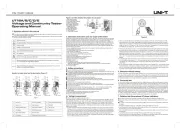
3 April 2025

3 April 2025

3 April 2025
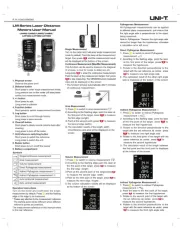
3 April 2025
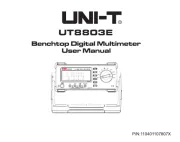
3 April 2025

3 April 2025

3 April 2025

3 April 2025

3 April 2025

3 April 2025
Handleiding Multimeter
- Steren
- IWH
- Topcraft
- PeakTech
- Maxwell
- TFA
- Multimetrix
- Proline
- MGL Avionics
- Testec
- EEVBlog
- Aldi
- Amiko
- Vimar
- Megger
Nieuwste handleidingen voor Multimeter
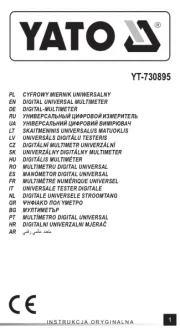
15 Juli 2025
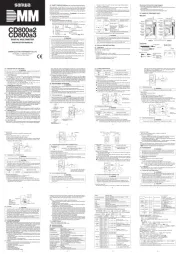
22 Juni 2025
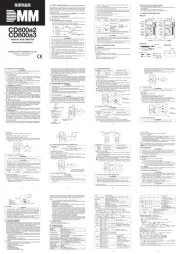
22 Juni 2025
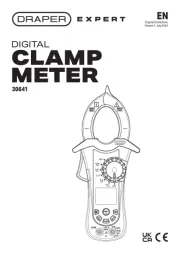
7 Juni 2025
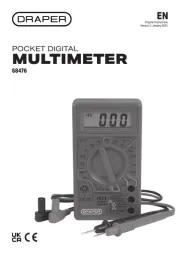
4 Juni 2025
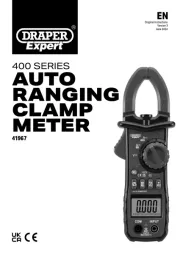
3 Juni 2025
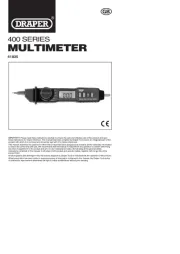
2 Juni 2025
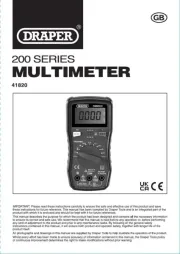
30 Mei 2025
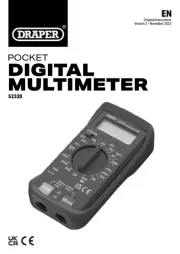
30 Mei 2025
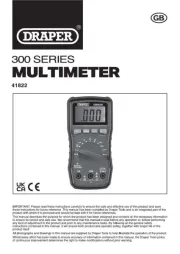
30 Mei 2025